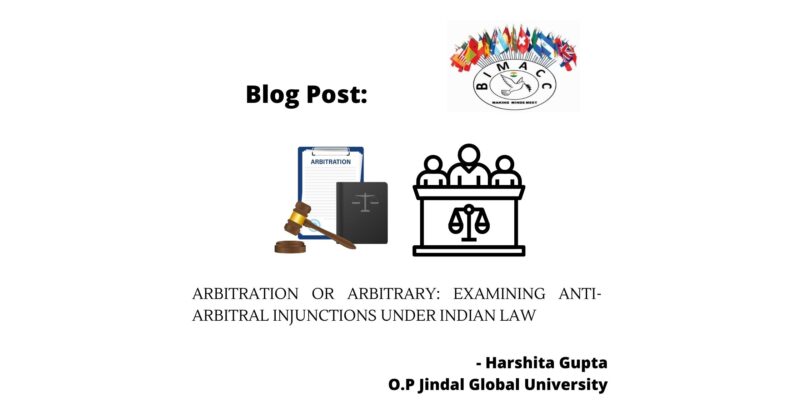
Arbitration or Arbitrary: Examining Anti-Arbitral Injunctions under Indian Law
In India, the judicial system faces significant challenges with overburdened courts, leading to extensive delays and mounting backlogs. The sheer volume of cases often hampers the timely dispensation of justice, creating frustration among litigants. In this context, arbitration emerges as a crucial solution, offering a more streamlined and efficient alternative. Arbitration is a nonjudicial legal technique for resolving disputes by referring them to a neutral party for a binding decision, or “award.”[1] Choosing arbitration over traditional litigation becomes a saviour for those seeking timely resolution, as it not only sidesteps the congested court system but also promotes a quicker, more cost-effective, and collaborative process. The private nature of arbitration ensures confidentiality, a factor especially valued in sensitive legal matters. As parties can select arbitrators with specific industry expertise, the process becomes more tailored and adept at addressing the complexities of modern disputes. As a result, arbitration becomes necessary and stands out as a beacon for individuals and businesses navigating the challenges posed by the overloaded Indian court system.
Arbitration, functioning as a confidential method for resolving disputes, operates independently of territorial jurisdiction.[2] Consequently, the ability to choose the venue for settling disagreements translates into the freedom to opt for a specific legal framework. This flexibility empowers parties involved to not only determine where the arbitration takes place but also to tailor the applicable legal principles to best suit their needs. In international arbitration, parties have the freedom to choose various elements such as the substantive law of the contract, the statutory law governing the arbitration agreement, and the procedural curial law. The arbitral seat, often described as the “centre of gravity” of arbitration, is critical as it determines important statutory considerations like challenges to arbitration. Notably, a contract’s governing law, which addresses validity, enforcement, breach, and remedies, may differ from the governing law of the arbitration clause due to the doctrine of severability.[3] The determination of the governing law involves a 3-stage test: checking for an express choice of law, or an implied choice, and if both are absent, applying the closest connection test. The closest connection test in arbitration involves determining the governing law by assessing either the law of the arbitral seat or the law of the underlying contract, depending on which has the closest connection to the arbitration agreement. While English courts favour the law of the seat, Indian courts, following the NTPC case,[4] assert that the law of the contract governs the arbitration agreement. However, conflicting jurisprudence and procedural inefficiencies in Indian courts have led to clauses excluding their jurisdiction, such as the Anti Arbitral injunctions [“AAI”]. To further examine this critical issue, one must look back at the sources of law, namely – the legislature and the judiciary.
- Under the statutory framework
An AAI is an injunction granted by courts to restrain parties or an arbitral tribunal from either commencing or continuing with arbitration proceedings.[5] It is typically requested prior to the start of an arbitration, during the arbitration proceeding, or following the conclusion of the substantive proceeding but before the judge issues the final award. However, there is no express provision that allows the granting of AAIs by courts, nor does any act explicitly prohibit it.
In India, the Arbitration and Conciliation Act, 1996,[6] governs arbitration proceedings, emphasizing limited interference by Civil Courts. Courts are obligated to refer parties to arbitration without initially addressing challenges to the arbitral tribunal’s jurisdiction, a mandate derived from the explicit provisions of Section 16 in conjunction with Section 5 of the Arbitration and Conciliation Act.[7] Section 16 embodies the Kompetenz-Kompetenz principle,[8] granting the arbitral tribunal the authority to adjudicate on its own jurisdiction, encompassing objections related to the existence and validity of the agreement. Additionally, the non-obstante clause in Section 5 underscores that, regardless of any other prevailing law, judicial intervention is restricted, except as explicitly provided for under the Act. This legal framework reinforces the autonomy of arbitral tribunals in determining their jurisdiction and minimizes court interference, aligning with the principle of Kompetenz-Kompetenz enshrined in national laws.[9]
Alternatively, certain nuances fail to recognize that arbitration referrals aren’t absolute. In civil court proceedings, Section 8 of the Act empowers courts to refer parties to arbitration unless there’s prima facie evidence of no valid arbitration agreement. Similarly, for foreign-seated arbitrations, Section 45 allows courts to refer parties to arbitration unless the agreement is deemed null, void, or incapable of performance. Section 45, being a non-obstante clause, is not restricted by Section 5 or the Kompetenz-Kompetenz principle in Section 16. Notably, court reviews under these provisions occur only in substantive civil court proceedings. Another layer of complexity arises from Section 89 of the Code of Civil Procedure,[10] directing disputes to ADR mechanisms. The Supreme Court’s clarification in Afcons Infrastructure Ltd. vs. Cherian Varkey Construction Co. (P) Ltd.[11] emphasizes the court’s role in facilitating ADR, paving the way for addressing related legal facets like anti-arbitration injunctions. Both Section 8 and Section 45 underscore that the statutory framework permits courts to grant AAIs, albeit under limited circumstances, such as the absence of a valid arbitration agreement or its nullity, inoperability, or incapability of performance, or if deemed just and convenient by the court.
II. As per the court’s interpretation
In cases where the legal position on certain subject matters appears unclear and confusing, courts often seek to bring clarity through judgments. Unfortunately, in India, the court’s interpretations and rulings have been notably inconsistent. While many orders empower arbitral tribunals to render final decisions, the diverse lines of reasoning adopted by the courts have resulted in an ad hoc state of the law.
In 2001, the Hon’ble Supreme Court, in the case of Kvaerner Cementation India Limited v. Bajranglal Agarwal, [12] ruled that a civil court lacks jurisdiction to adjudicate on objections regarding the existence or validity of an arbitration agreement due to the Kompetenz-Kompetenz principle outlined in Section 16 of the Act.[13] Unfortunately, Kvaerner did not reference any prior cases or offer detailed reasoning for this decision. Moreover, the case was reported only in 2012, 11 years after the judgment was delivered. In the case of Chatterjee Petrochem Co. v. Haldia Petrochemicals Ltd.,[14] the Court restated its stance and invoked section 5 of the Act to affirm that “a suit filed with the aim of seeking an anti-arbitration injunction would not be maintainable in law.”[15] In World Sport Group v. MSM Satellite Singapore Ltd,[16] the Supreme Court asserted that the only barriers to directing parties towards foreign-seated arbitrations are confined to the stipulations in Section 45 of the Arbitration Act.[17] This encompasses instances where the arbitration agreement is either (i) deemed null and void; (ii) rendered inoperative; or (iii) proven incapable of execution.
However, the Indian judiciary’s position on the issuance of anti-arbitration injunctions faced challenges once again in the cases of A. Ayyasamy v. A. Paramasivam[18] and NALCO case,[19] where the Court reaffirmed the precedent set in Kvaerner. In a prior instance, the Delhi High Court’s division bench, in McDonald’s India Private Limited v. Vikram Bakshi and Ors., [20] addressed the jurisdiction of Civil Courts to grant anti-arbitration injunctions in arbitrations governed by the Act. The court determined that Civil Courts could exercise jurisdiction to grant such injunctions if it was established that the arbitration agreement was null, void, inoperative, or incapable of being performed. The NALCO case in 2020 emphasized that objections to the arbitration agreement’s existence and validity should be addressed before the Arbitral Tribunal and upheld the civil court’s decision to refrain from interference. [21]
In the case of Beena Modi,[22] the court held that AAI suits are not maintainable due to the availability of an alternative remedy under Section 16 of the Arbitration Act.[23] It refused to consider the Division bench judgment in McDonald’s case, asserting that it did not adhere to Supreme Court dicta and emphasized that the Arbitration Act is a self-contained legal framework. The court highlighted the Act’s provision empowering the arbitral tribunal to decide on its jurisdiction (kompetenz-kompetenz). Additionally, Section 41(h) of the Specific Relief Act, 1963, [24] was cited to argue that approaching the arbitral tribunal under Section 16 provides an equally efficacious remedy, barring the grant of injunctions.
In conclusion, the jurisprudence on anti-arbitral injunctions in India reflects a delicate balance between preserving arbitration’s autonomy and preventing abuse of the arbitral process. The Supreme Court, exemplified in cases like Kvaerner and the NALCO case, consistently emphasizes the principle of kompetenz-kompetenz, affirming the Arbitral Tribunal’s authority over its jurisdiction. While the Delhi High Court distinguishes between anti-arbitral and anti- suit injunctions, upholding arbitration’s autonomy, the Calcutta High Court appears to treat them similarly. This divergence underscores the evolving nature of judicial interpretations. In essence, the evolving jurisprudence underscores the ongoing tension between respecting arbitration’s autonomy and safeguarding against potential abuse, requiring courts to judiciously grant anti-arbitral injunctions in alignment with arbitration law principles.
-Harshita Gupta
Intern
O.P. Jindal Global University
[1] Domke, Martin, “arbitration”, Encyclopaedia Britannica, (Dec 20, 2023, 10:04 AM), https://www.britannica.com/topic/arbitration.
[2] Aarohi Chaudhari, A-Z OF ADR: GOVERNING LAW, BIMACC, (Dec. 20, 2023, 10:08 AM), https://www.bimacc.org/a-z-of-adr-governing-law/#_ftn2.
[3] Section 16, Arbitration and Conciliation Act, INDIA CODE (1966).
[4] NTPC v Singer, (1993) AIR SC 998, (India).
[5] Julian Lew, “Control of Jurisdiction by Injunctions Issued by National Courts” in International Arbitration 2006: Back to Basics? International Council for Commercial Arbitration Congress Series No 13 (Albert Jan van den Berg ed), (Kluwer, 2007), pp 185–220.
[6] Arbitration and Conciliation Act, INDIA CODE (1996).
[7] Supra note 3 at 7.
[8] The principle of Kompetenz-Kompetenz dictates that an arbitral tribunal is empowered to rule on its own jurisdiction, including, determining all jurisdictional issues and the existence or validity of an arbitration agreement. It is regarded by many scholars as the “bedrock principle” of arbitration, and it finds reference in laws governing arbitration globally.
[9] Varun Tyagi, The Muddy Waters of Anti-Arbitration Injunctions in India, The American Review of International Arbitration, Colombia Law School, Nov. 17, 2021.
[10] Section 89, Civil Procedure Code, INDIA CODE (1908).
[11] Afcons Infrastructure Ltd. vs. Cherian Varkey Construction Co. (P) Ltd, (2010) 8 SCC 24, (India).
[12] Kvaerner Cementation India Limited v. Bajranglal Agarwal and Another, (2012) 5 SCC 214 (India).
[13] Supra note 3 at 13.
[14] Chatterjee Petrochem Company v. Haldia Petrochemicals Limited, (2014) 14 SCC 574 (India).
[15] Section 5, Arbitration and Conciliation Act, INDIA CODE (1966).
[16] World Sport Group (Mauritius) Limited v. MSM Satellite (Singapore) Pte. Limited, (2014) 11 SCC 639 (India).
[17] Section 45, Arbitration and Conciliation Act, INDIA CODE (1966).
[18] A. Ayyasamy v. A. Paramasivam and Others, (2016) 10 SCC 386 (India).
[19] National Aluminium Co. Ltd. v. Subhash Infra Engineers (P) Ltd, (2020) 15 SCC 557 (India).
[20] McDonald’s India Private Limited v. Vikram Bakshi & Ors, 2016 (4) ARbLR 250 (India).
[21] Supra note 19 at 21.
[22] Dr. Bina Modi v. Lalit Kumar and Others, 2020 SCC OnLine Del 1678 (India).
[23] Supra note 3 at 23.
[24] Section 41(h), Specific Relief Act, INDIA CODE (1963).
Disclaimer: The views and opinions expressed in this blog are those of the author and do not necessarily reflect the official policy or position of BIMACC, any of the members of the Board, or the empanelled neutrals.
